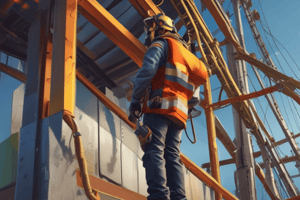Podcast
Questions and Answers
What is the purpose of a risk assessment?
What is the purpose of a risk assessment?
- To determine the profitability of a workplace
- To provide workers with personal protective equipment (PPE)
- To ensure compliance with safety regulations
- To identify potential hazards and evaluate the likelihood of those hazards (correct)
What specific requirements are outlined in the Australian Work Health and Safety Regulations 2011 for working at heights safety?
What specific requirements are outlined in the Australian Work Health and Safety Regulations 2011 for working at heights safety?
- The duty to ensure that workers are competent to work at heights
- The requirement to provide workers with personal protective equipment (PPE)
- The need to conduct regular safety equipment inspections
- The need for a safe work method statement (SWMS) when working at heights (correct)
Which of the following is considered appropriate safety equipment for working at heights?
Which of the following is considered appropriate safety equipment for working at heights?
- Office chairs
- Fall arrest systems (correct)
- Water coolers
- Desktop computers
What must workers be trained in according to the Work Health and Safety Regulations 2011?
What must workers be trained in according to the Work Health and Safety Regulations 2011?
What is the duty of employers and others in control of workplaces according to the Work Health and Safety Act 2011?
What is the duty of employers and others in control of workplaces according to the Work Health and Safety Act 2011?
Flashcards
Fall Protection Systems
Fall Protection Systems
These systems prevent falls or minimize their impact, utilizing personal or collective safety equipment.
Risk Assessment (Heights)
Risk Assessment (Heights)
A step-by-step process to identify potential height-related dangers, analyze their impact, and decide on control measures.
Australian Work Health and Safety Regulations
Australian Work Health and Safety Regulations
Laws in Australia that mandate the management of workplace heights safety practices, including safe work method statements and fall prevention plans.
Safe Work Method Statement (SWMS)
Safe Work Method Statement (SWMS)
Signup and view all the flashcards
Personal Protective Equipment (PPE)
Personal Protective Equipment (PPE)
Signup and view all the flashcards
Study Notes
Working at Heights Safely in Australia: Fall Protection, Risk Assessment, Regulations, and Safety Equipment
Working at heights poses inherent hazards in Australia, as the country is home to numerous tall structures, industrial facilities, and construction sites. To ensure a safe working environment and protect workers from falls, it's crucial to understand the specific safety requirements and best practices for working at heights in Australia. In this article, we'll explore the essential elements of fall protection, risk assessment, regulations, and safety equipment.
Fall Protection
Fall protection is a critical aspect of working at heights safety. Fall protection systems include personal fall protection equipment, such as harnesses, lanyards, and anchors, as well as collective protection systems like guardrails, safety nets, and fall arrest systems. These systems are designed to prevent workers from falling, or if a fall occurs, to minimize the impact and potential injuries.
Australian Standard AS/NZS 1891.4:2009 provides guidelines for the selection, use, and maintenance of fall protection systems. To ensure compliance, it's essential to choose equipment that meets these standards and to follow the manufacturer's instructions for installation, inspection, and maintenance.
Risk Assessment
Risk assessment is a fundamental step in working at heights safety. A risk assessment helps identify potential hazards, evaluate the likelihood and consequence of those hazards, and determine appropriate control measures. In Australia, the Work Health and Safety Act 2011 and its associated regulations require employers and others in control of workplaces to manage risks to health and safety.
When conducting a risk assessment for working at heights, consider:
- The nature of the work
- The location of the work
- The conditions of the work
- The potential hazards
- The available control measures
- The likelihood and consequence of incidents
- The effectiveness of existing safety measures
Regulations
The Australian Work Health and Safety Regulations 2011 outline specific requirements for working at heights safety. These include:
- The need for a safe work method statement (SWMS) when working at heights
- The requirement for a fall prevention plan
- The duty to provide safe access and egress arrangements
- The duty to provide adequate training, instruction, and supervision
- The duty to ensure that workers are competent to work at heights
When working at heights in Australia, workers and employers must be familiar with these regulations and ensure that they are strictly followed.
Safety Equipment
Safety equipment is a critical component of working at heights safety. According to the Work Health and Safety Regulations 2011, personal protective equipment (PPE) must be provided and used by workers in the workplace. Appropriate safety equipment for working at heights includes:
- Harnesses
- Lanyards
- Anchors
- Safety nets
- Guardrails
- Fall arrest systems
- Work positioning systems
- Barriers
- Signs and labels
- Safety training and instruction
Safety equipment must be selected, inspected, maintained, and replaced according to the manufacturer's instructions and Australian Standards. Additionally, workers must be trained in the proper use of safety equipment and know how to inspect it regularly.
In conclusion, working at heights safely in Australia requires a comprehensive understanding of fall protection, risk assessment, and safety equipment. By following the guidelines set forth by relevant standards and regulations, workers and employers can protect themselves from the inherent hazards of working at heights and contribute to a safer, more productive work environment.
Studying That Suits You
Use AI to generate personalized quizzes and flashcards to suit your learning preferences.
Description
Test your knowledge of fall protection, risk assessment, regulations, and safety equipment for working at heights in Australia. Learn about the essential elements required for a safe working environment and how to protect workers from falls.




